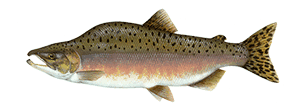Pink Salmon

Species Details
Oncorhynchus Gorbuscha
Salmonidae
Salmoniformes
Onshore, Lake, River
3 - 5 lbs.
20" - 30"
Pink Salmon (Oncorhynchus Gorbuscha) Fish Description
Also known as the Humpback Salmon, the Pink Salmon is the smallest and the most abundant among the Pacific Salmon. The Pink Salmon appear as bright silver in the oceans but in streams, they gain back their light yellowish-white underbelly. Some others have a dull green color. Though, it highly depends on where they are.
Pink Salmon are most noted for their slight hump on their back, hence their name. They also don’t have teeth on their tongues. But Pink Salmon have large black oval spots on their back and their tail fins. They also have deep forked-tail and an anal fin that has 13-17 soft rays.
Pink Salmon Diet and Size
Pink Salmon often eat plankton. However, they also eat smaller fish, squid, and occasionally – Aquatic Insects. Pink Salmon average between 4.8 lbs (2.2 kg) in weight. However, someone managed to record a pink salmon being 30 inches and weighing around 15 lbs (6.8kg).
Interesting Facts about the Pink Salmon
- Pink Salmon often have a short life cycle of around 2 years.
- Pink Salmon love cold water.
- The crustaceans that Pink Salmon eat are what make the salmon’s fillet pink.
- A lot of people love eating pink salmon. Some even say that pink salmon are known for their omega-3 content. However, pink salmon may not be good for those who have high uric acid as it can cause gout.
- Pink Salmon is eaten in different ways. It can be smoked, baked, fried, and grilled. Some cuisines like employing the poêle method, allowing it to cook in its own juices. This helps achieve a crispy skin but soft texture.
- In Asian countries, Pink Salmon can be eaten raw. Japanese usually serve it as sushi or nigiri where it’s known as Sake.
- Southeast Asian countries often eat their Pink Salmon grilled. Some also eat it as part of a sour soup called Sinigang which is usually a tamarind soup-base with some vegetables such as swamp cabbage, tomatoes, and eggplant. Some people may also use Bilimbi or Kamias as the base of the soup.
- Pink Salmon are commonly enjoyed for their fillet and their belly. Eastern countries also enjoy eating from the head.
- The belly of the Pink Salmon is said where all the Omega-3 oils are.
- Pink Salmon often don’t interbreed. But when they do, their hybrids often come out sterile.
Pink Salmon – Fishing Techniques: How to Fish for a Pink Salmon
For fishing Pink Salmon, you’ll need a medium action rod. As for the reel, it will depend on how you’re catching them. For casting, you’ll need a reel that holds 150 yards. Or at least, 8 to 10 lbs. For a jig, some anglers recommend brightly colored jigs. The most color that anglers use is pink in order to attract the pink salmon. This may be to fool the fish into thinking that the jig is a crustacean. They also use a pink hoochie which looks like a squid.
To make it more attractive, some people smear fish oil onto the jig to attract them. Some use herring oil. Others use squid oil.
Pink Salmon is a good fish to start for beginners. Anglers would often say that the Pink Salmon is one way to start if one wants to mimic the pros.
Pink Salmon Habitat
Pink Salmon loves cold water especially if it’s around 10 degrees Celsius. They’re native to Pacific and Arctic coastal waters and rivers. Pink Salmon sometimes are in creeks and lakes. But they do like their place in rivers. They also stay in sea basins.







